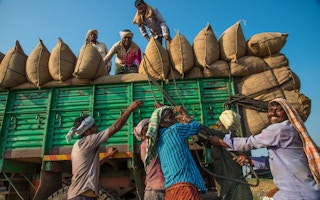India’s Crop Insurance Scheme Leaves Vulnerable Farmers Exposed
As climate change intensifies, India’s farmers, particularly those in climate-vulnerable districts, are facing significant challenges. A government-backed crop insurance scheme, intended to protect them from extreme weather events, is failing to deliver on its promise, according to a recent analysis.
Dileep Patidar, a farmer in the Mandsaur district of Madhya Pradesh, knows these challenges firsthand. After consecutive years of low rainfall ravaged his soybean crops, he planted urad, a pulse requiring less water, and relied on the insurance scheme. Unfortunately, his gamble failed, resulting in nearly half of his crop being lost.
“I last received an insurance payout in 2019, and I’ve lost crops to low rainfall almost every year since then,” said the 49-year-old farmer, who cultivates five hectares.
The Indian government operates the world’s largest agricultural crop insurance program, subsidizing premiums to make insurance more accessible. However, an analysis by the Centre for Science and Environment (CSE), a Delhi-based think tank, reveals a troubling reality. Farmers in climate-vulnerable districts, like Patidar’s Mandsaur, are burdened with higher premiums, receive lower insurance coverage, and experience reduced payouts compared to farmers in lower-risk areas.
“Farmers must perceive a benefit in adopting it which means those vulnerable have to pay less, if at all, for better support.”
According to India’s Atlas of Disasters, maintained by CSE, climate change is increasingly impacting India’s crops, with over 4 million hectares affected by extreme weather events in 2024. That’s nearly double the previous year.

With approximately 46% of India’s 1.4 billion population employed in agriculture, the sector supports 70% of rural households and contributes 16% to the country’s GDP, according to government data. The situation is particularly frustrating for farmers like Patidar, who have diligently paid their premiums, only to find their claims delayed or denied. He recounted checking his bank passbook, seeing around 10,000 rupees (US$115) deducted for the insurance premium, “but to what end?”
Launched in 2016, the Pradhan Mantri Fasal Bima Yojana (PMFBY) aimed to insure 50% of all agricultural land by 2020; however, official data shows that only 30% was insured by 2021.
Amit Khurana, Programme Director at CSE, emphasizes the potential of the crop insurance scheme as a critical safety net for climate-vulnerable farmers. He stresses the need for farmers to recognize the benefits of the scheme, which necessitates lower premiums or greater support for the most vulnerable. Currently, this is not the case.
The CSE’s analysis of 2023 monsoon crop insurance data examined 21.5 million farmers spread across agricultural districts categorized by the Indian government as highly susceptible to climate change risks. The analysis showed farmers in the most vulnerable districts pay 70% more in premiums than those in lower-risk districts and 60% more than those in high-risk districts. Despite the higher investment, farmers in these vulnerable districts received 20% less in insurance payouts.
Donthi Narasimha Reddy, a public policy expert in the southern state of Telangana, highlighted the lack of transparency in the scheme as a significant challenge, with farmers often reporting delayed or insufficient payouts.
To improve the effectiveness of the insurance, Khurana suggests that state governments employ technology to enhance the process. He cites Andhra Pradesh as a model, which in 2018 introduced a digital crop survey using satellite technology to track crop yields, complementing the existing physical surveys.
D. Venugopal, deputy director of the state’s crop insurance department, stated that greater transparency has helped Andhra Pradesh reduce the premium paid by farmers to around 4% of the total, compared to the national average of about 10%. The central and state governments cover the remaining costs.
The Indian government is also taking steps to modernize crop insurance through technology and aims to launch digital crop surveys in all districts by March 2026. This will involve mobile apps, GPS, artificial intelligence, and machine learning to refine crop yield estimates, enhancing the efficiency and transparency of the insurance scheme and streamlining claim settlements.
For farmers like Patidar, who are struggling with the effects of climate change, change cannot come soon enough. “I’m not getting a break,” he said. “The government must resolve these issues soon. Otherwise, where will the food come from?”


